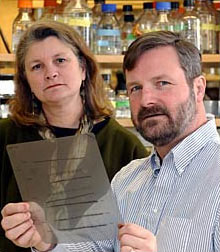
For Release: May 24, 2007
Contact: DMS Communications 603-650-1492
Jet Lag: Light, Chemicals, Action
Research Reveals Biology of Circadian Clock
HANOVER, NH—It's in the timing—and the circadian clock that cues the ebb and flow of our daily rhythms. Frequent fliers who go through several time zones know the jet lag that can occur when timing is disrupted.

Jennifer Loros and Jay Dunlap
Now, new research by Dartmouth and Cornell scientists explains the biological mechanism behind how circadian clocks sense light through a process that transfers energy from light to chemical reactions in cells. The research was published in the May 18 issue of Science.
Internal cellular clocks respond to differences in light between night and day, allowing organisms to anticipate changes in the environment by pacing their metabolism to this daily cycle. They help safeguard timing of key processes in most organisms: when blooming plants open their petals in the morning and close them at night, when fungi release spores to maximize reproductive success, or when people go to sleep at night and awake in the morning. Disruption of human living clocks, which control major regulatory functions, is linked to jet lag, seasonal affective disorder sleep disturbances, mental illness, perhaps some cancers.
These biological timekeepers are ubiquitous and essential, according to DMS co-author Jay Dunlap, professor and chair of genetics. Working in the fungus Neurospora crassa, better known as bread mold, he and another co-author, Jennifer Loros, professor of biochemistry and of genetics, were the first to demonstrate the how light and dark cycles reset the circadian watch, the way turning the clock hands does. The parallels in this relatively simple model system offer clues to what makes higher organisms tick. "The wiring is quite similar even though some aspects of the proteins involved are different," said Dunlap.

The new study revealed how Neurospora uses circadian clock light sensors to control production of carotenoids, which protect against damage from the sun's ultraviolet radiation just after sunrise.
The researchers studied a protein called vivid, which contains a chromophore—a light-absorbing molecule. The chromophore captures a photon or particle of light. The captured energy from light triggers a series of interactions that ultimately lead to conformational changes on the surface of the vivid protein. These structural protein surface changes kick off a cascade of events that affect the expression of genes, such as those that turn carotenoid production on and off.
By substituting a single atom (sulphur for oxygen) on the vivid protein surface, the researchers were able to shut down the chain of events and prevent the structural changes on the protein's surface, thereby disrupting the regulation of carotenoid production. The change in protein conformation affects its cellular function.
The circadian clock allows the fungus to regulate and produce carotenoids only when they are needed for protection against the sun's rays. A similar "switch" may be responsible for timing the sleep cycle in humans.
Co-authors included Carsten Schwerdtfeger of DMS, along with Brian Crane, Brian Zoltowski, Alexandrine M. Bilwes and Joanne Widom of Cornell. The study was supported by grants from the National Institutes of Health.
-DMS-